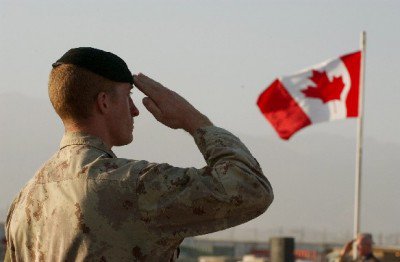Racism: A Systemic Problem in The Canadian Military

Anti-blackness is a significant problem in the Canadian Forces. For decades it was explicit and the institution evidently remains structurally racist.
Last month it was revealed that a white reservist who repeatedly called black soldiers “n…ers” would not face any disciplinary measures. The stated reason was that the individual, whose father is a senior reserve soldier, was “under a lot of pressure” during training. Incredibly, during the investigation Defence Minister Harjit Sajjan inquired about the treatment of the accused — not the victims — after the mother of the soldier who made the slurs complained to his office.
This recent case is not an isolated incident. In 2016 two black and one indigenous member of the CF sued over systemic racism. The former soldiers’ suit claimed that “derogatory slurs, racial harassment and violent threats are tolerated or ignored …. Victims of racism within the Canadian Forces are forced into isolation, subjected to further trauma and, in many cases, catapulted toward early release.”
One of those who launched the suit is Wallace Fowler who has detailed his experience of racism in a series of articles and a book titled Checkmate. In the early 2000s his daughter was spat on in school, a bus driver called his son a “n…ers” and his wife had bananas thrown at her at the Esquimalt, British Columbia, base where he was stationed. Fowler filed numerous official complaints, which were effectively ignored. Worse still, he faced retribution and an apparent cover-up, highlighting systemic racism in the CF.
Fowler’s experience took place not long after revelations of anti-blackness in the force came to light in the years after the 1992-93 Somali mission. Corporal Matt Mackay, a self-confessed neo-Nazi who declared he’d quit the white supremacist movement two years before going to Somalia, gleefully reported “we haven’t killed enough ‘n…ers’ yet.” Another Canadian soldier was caught on camera saying the Somalia intervention was called, “Operation Snatch Nig-nog.” The only black soldier in the Airborne Regiment deployed to Somalia, Lawrence Brathwaite, said he was told “black people are evil”, repeatedly called “boy” and a black officer was labeled “N.O.” (“n…er officer”).
Of course, the anti-blackness on display over the past quarter century pales in comparison to the first half of the last century. During World War I Black-Canadians seeking to fight in Europe faced a great deal of prejudice. In November 1915 the commander of the 104th Battalion released 17 black recruits. In response to criticism of this move, Lieutenant Colonel G. W. Fowler said,
“I have been fortunate to have secured a very fine class of recruits, and I did not think it fair to these men that they should have to mingle with negroes.”
Chief of the General Staff, General W.G. Gwatkin, opposed African Canadian enlistment. In the midst of a recruiting crisis in April 1916 he wrote:
“The civilized negro is vain and imitative; in Canada he is not impelled to enlist by a high sense of duty; in the trenches he is not likely to make a good fighter.”
After two years of campaigning to be allowed to join, the military authorized a black construction battalion in July 1916. The Nova Scotia raised battalion was under the command of white officers. Not allowed to fight or attend recreational activities with other CF units, they cut lumber, dug trenches and built huts. Some government officials wrote “nigger” on their documents.
In the interwar period the black community in Nova Scotia was largely excluded from the militia. A survey of 14 militia units in the 1930s found that none wanted black personnel, calling instead for the formation of coloured units or sub-units.
For most of the first half of the 1900s Navy and Air Force racism was codified (though local recruiters sometimes failed to follow official policy, and it was removed and reinstated depending upon public relations and institutional needs). Responsible for Canada’s nascent naval forces, Britain’s “Regulations for the Entry of Naval Cadets” in 1906 said, “candidates must be of pure European descent.” In 1938 the Royal Canadian Navy (RCN) and Royal Canadian Air Force (RCAF) initiated exclusionary policies, which Cabinet quickly approved. The policy required recruits to be of “Pure European Descent and of the White Race.”
Three years later the RCAF’s deputy director of manning in the personnel branch at headquarters, H.P. Crabb, issued a clarification letter to all recruiting offices regarding “Orientals and Negro applicants”. It stated, “only those of European descent will be accepted for appointment or enlistment in Aircrew.” In other words, black and Asian applicants could enlist but they were only eligible for less prestigious ground duty positions.
At the start of 1946 the RCAF reinstated the requirement that applications from black, “Oriental”, and “former enemy aliens” be forwarded to headquarters for approval. Denying there were restrictions placed upon the eligibility of “coloured applicants”, the Chief of the Air Staff claimed“coloured” applications had to be sent to headquarters to “carefully scrutinize” whether the applicant could “mix” with whites, which was “for the protection and future welfare of the applicant.” The policy was still employed by the RCAF in 1956.
Even after the end of openly racist enlistment policies, sought-after ranks in the RCAF and RCN, as well as the army, were reserved for white men. It wasn’t until 2016, for instance, that a black person captained a sea-going RCN vessel.
The CF has largely failed to recognize its history of racist enlistment policies. There has not been an official apology, let alone affirmative action policies to correct the injustice.
As the force’s seeming indifference to a reservist’s slurs suggests, anti-blackness remains a significant issue in the Canadian Forces.
*
Note to readers: please click the share buttons above. Forward this article to your email lists. Crosspost on your blog site, internet forums. etc.

